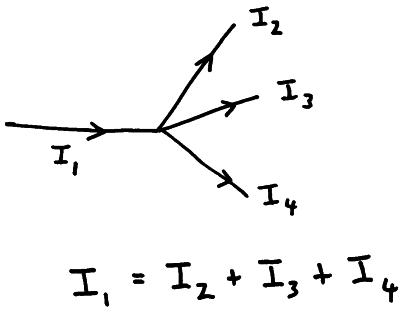 |
| Kirchhoff's 1st Law! |
Gustav Kirchhoff has two key laws to deal with in AS Physics.
His 1st law states that "The current entering a junction is equal to the current exiting a junction."
This law is displayed above where a current, I1, enters a junction and three currents: I2, I3 and I4 exit a junction.
The equation highlights that I1 is equal to I2 + I3 + I4 and therefore that the current entering the junction (I1) is equal to the current exiting the junction (I2 + I3 + I4) and thus Kirchhoff's 1st law is accurate.
Kirchoff's 1st law is evidence that charge is conserved in a circuit.
This is proved as I = Q / t.
As I is the same at the entry point and exit point of the junction this means Q / t must also be the same at the entry and exit point. As the time is a fixed value this implies the charge must also remain conserved.
Have you got any confusions with this topic?
How about any example calculations to support someone who is not so sure?
Do you have any additional ways of explaining this to assist your peers?
Please comment below to add support for the other members of the group.
Question:
Given the following data solve the ammeter readings for the remaining ammeters (C, E and H)
A - 10A
B - 3A
D - 5A
F - 4A
G - 1A
Post your answers below!
You might need to click on comments to add your own!

C=2A
ReplyDeleteE=3A
H=10A
C - 2A
ReplyDeleteE - 3A
C - 2A
ReplyDeleteE - 3A
NJXxx
C=2A
ReplyDeleteE=3A
H=10A
C=2A
ReplyDeleteE=3A
H=10A
C=2A
ReplyDeleteE=3A
H=10A
C=2A
ReplyDeleteE=3A
H=10A
Thank You and that i have a super proposal: How Much Should House Renovations Cost home repairs contractors
ReplyDelete